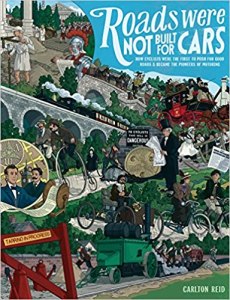…but then nor do you.
I continue to see claims that cyclists should not be on the road because they don’t pay “road tax” such as this one yesterday which seems to have been subsequently removed:

So let’s get some things straight:
There’s no such thing as “road tax”
There used to be. But it was abolished by Winston Churchill in 1937 and replaced by Vehicle Excise Duty (VED) – a tax that goes straight into the exchequer – it doesn’t directly pay for roads – it wouldn’t be anywhere near enough anyway. The excellent, and ironically named, website I Pay Road Tax, run by transport journalist Carlton Reid, is campaigning for it to be referred to as “car tax” which is effectively what it is.
Roads are funded from general taxation
Anyone who pays VED, income tax, VAT, inheritance tax or a myriad of other taxes is helping to pay for the roads. Roads are a resource legally available to everyone – motorists, delivery drivers, emergency services, the military, motor cyclists, cyclists, pedestrians and soon, probably, e-scooterists (although at the time of writing e-scooters are defined as vehicles and are not legal to use in the UK either on the road or on the pavement – this may soon change).
Update: As of 4th July 2020 it’s legal for hired e-scooters to be used in the UK on roads, cycle lanes and cycle tracks (NOT pavements). Privately owned scooters are still not legal in a public place. You have to be at least 16, hold at least a provisional driving license and are limited to 15.5mph. Helmets are advised but not mandatory.
Bicycles are not liable for VED
VED is a tax based on a vehicle’s emissions. A bike isn’t a vehicle (according to the Road Traffic Act) and it has no emissions. So it’s exempt.
Other exemptions include disabled drivers, electric vehicles, military vehicles and police cars. And pedestrians. Next time Ryan is stopped by the police I suggest he tries telling them they have no right to use the road because they don’t pay “road tax” and see how far he gets.
Also many cyclists also own a motor vehicle, on which they pay VED. And if they’re cycling then their vehicle isn’t clogging up the road, so when you’re driving and you next see a cyclist, don’t think “they don’t pay road tax” think “they’ve left their car at home which leaves more space for me”.
Many cyclists do have insurance
Members of Cycling UK (about 68,400 members) and the London Cycling Campaign (about 11,000) are covered by third-party insurance as a benefit of their membership. I’m a member of the LCC, so I am covered by third-party insurance when I ride my bike. Many home insurance contents policies also include third-party liability and will therefore cover claims against the policy-holder or members of their household while cycling.
There are some badly-behaved cyclists
I stop at red traffic lights and at pedestrian crossings, but not all cyclists do. Then again not all motorists do. When I cycle commuted across London the vehicles I saw jump red lights most often were buses, taxis and white vans. The police, quite rightly, enforce the law for everyone, however, as Superintendent Andy Cox of the Metropolitan police explains, the police target their resource to maximise road safety:

If you consider countries where cycling is ubiquitous such as Denmark or the Netherlands, there are many fewer instances of badly-behaved cyclists. This is generally because the infrastructure is better suited to cycling. When you’re cycling, stopping and restarting requires a lot of effort, so cyclists will try to avoid this. Some do this by cycling through pedestrians on a crossing or failing to stop at traffic lights. Not a good idea. But better infrastructure which separates bikes from other traffic, and from pedestrians, enables cyclists to keep going. Cycle lanes are good, but those which require the cyclist to give way at every side road (there’s one like that near me between Marlow and Bourne End) and which mixes cyclists and pedestrians are simply not going to get used.
There are other reasons. In Denmark there’s a law of “presumed liability” which means, unless there is clear evidence to the contrary, the more vulnerable road user is considered the victim in an accident. So in a cyclist vs pedestrian collision the cyclist is at fault, and in a cyclist vs car, the motorist is at fault. This encourages more considerate behaviour. Also in Denmark if a cyclist is convicted of an offence they can get points on their car driving license, or even lose it. Maybe we should consider some changes to the law like that in the UK?
And finally, some reading…
The previously-mentioned Carlton Reid has written a fascinating book: Roads Were Not Built For Cars – How Cyclists Were the First to Push for Good Roads & Became the Pioneers of Motoring available at your local bookshop, Hive or, if you must, Amazon.

